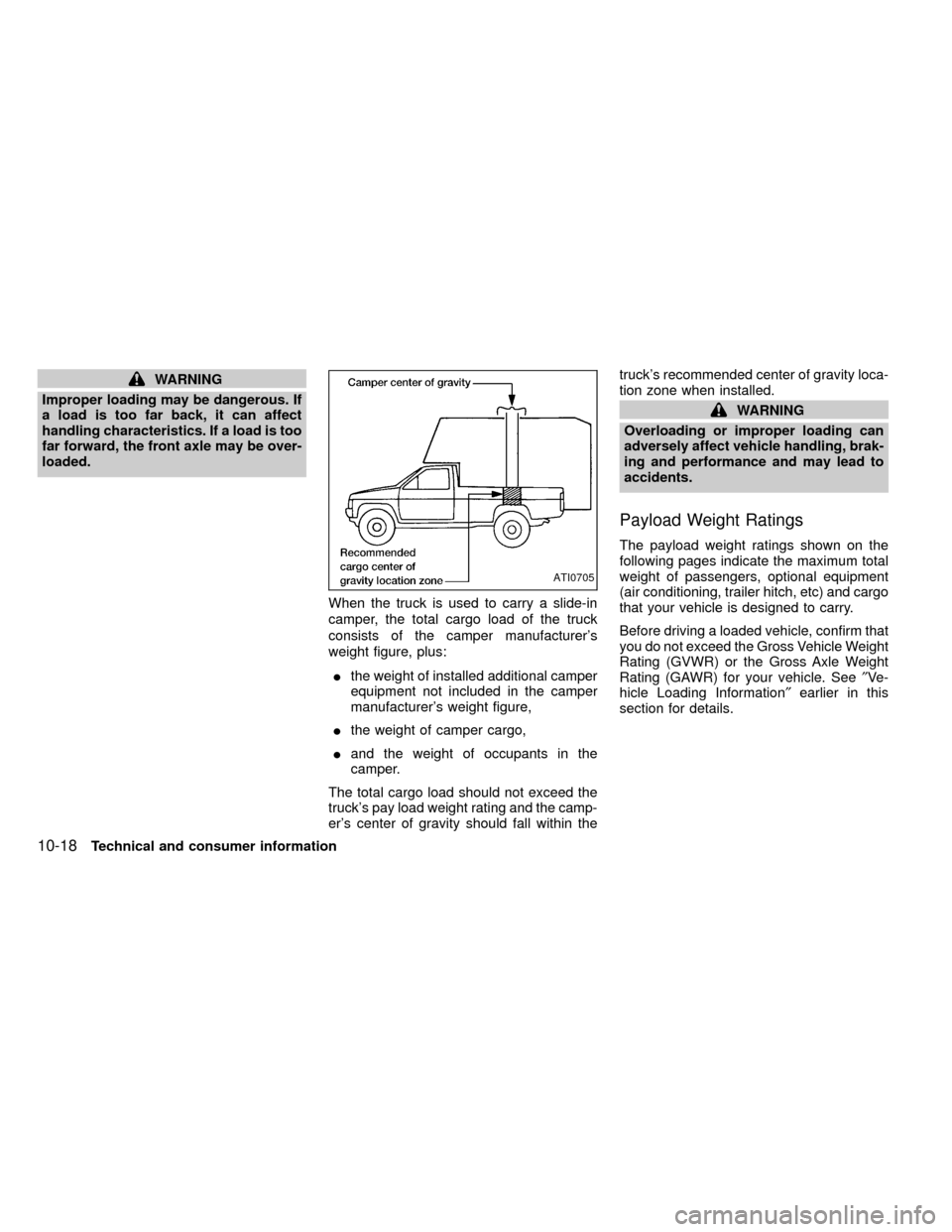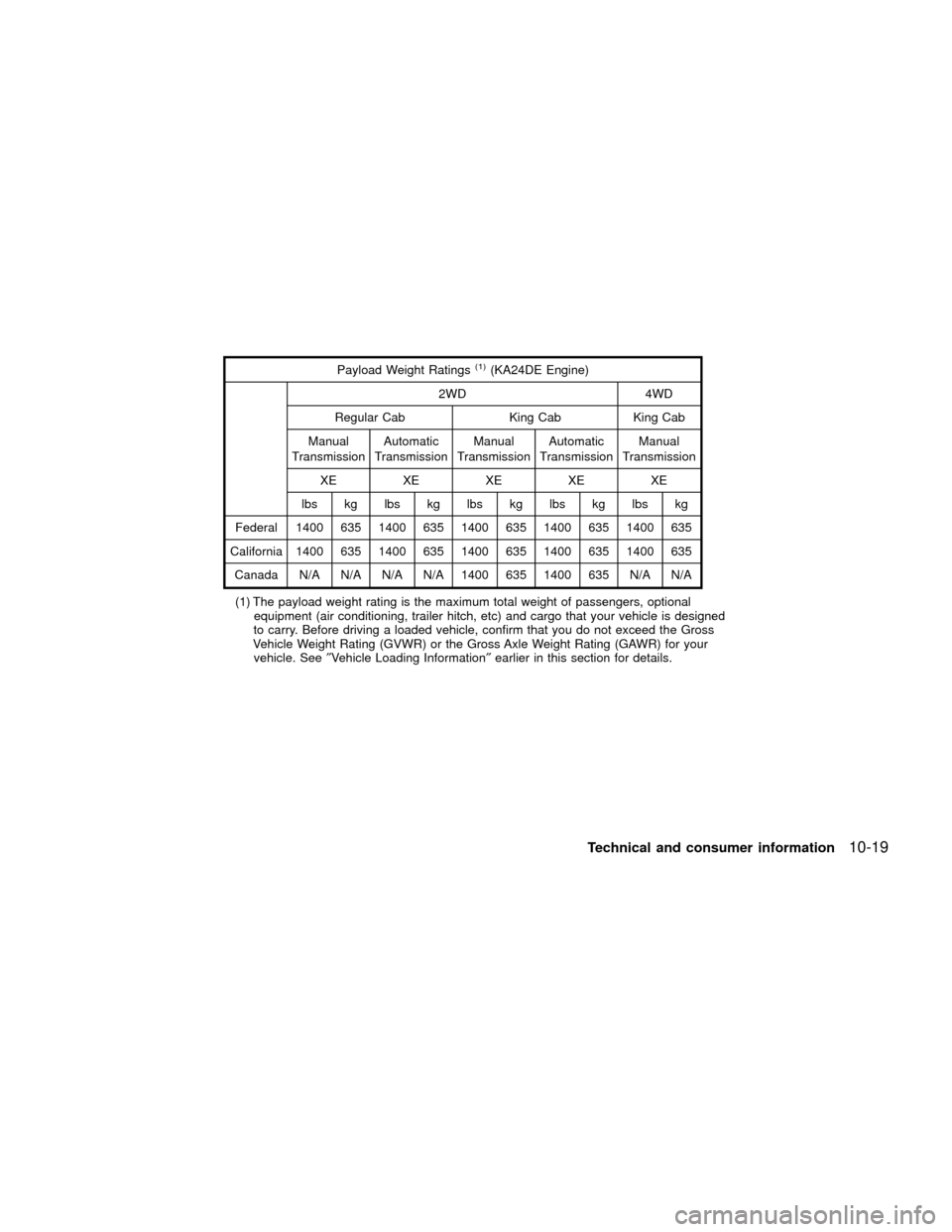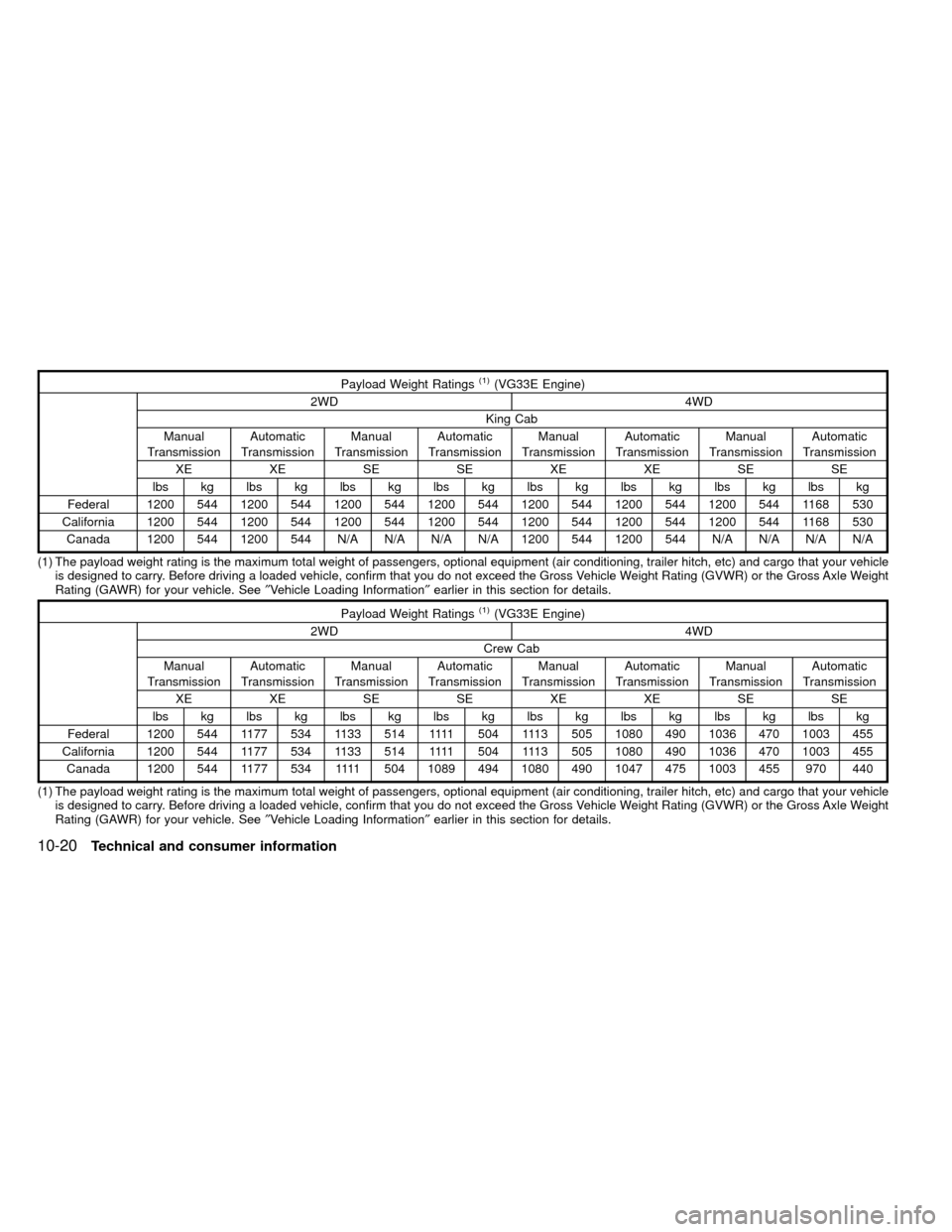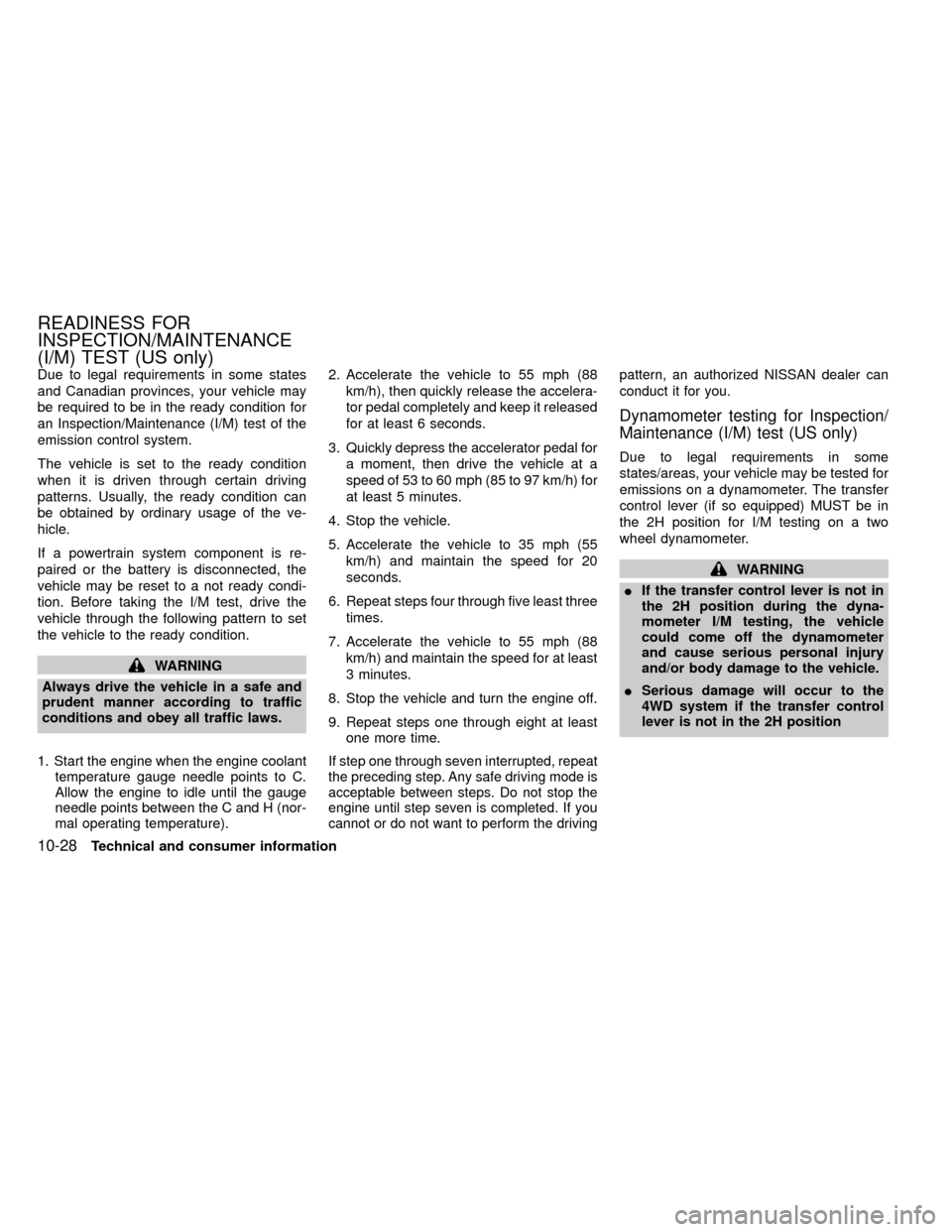2000 NISSAN FRONTIER air condition
[x] Cancel search: air conditionPage 250 of 269

WARNING
Improper loading may be dangerous. If
a load is too far back, it can affect
handling characteristics. If a load is too
far forward, the front axle may be over-
loaded.
When the truck is used to carry a slide-in
camper, the total cargo load of the truck
consists of the camper manufacturer's
weight figure, plus:
Ithe weight of installed additional camper
equipment not included in the camper
manufacturer's weight figure,
Ithe weight of camper cargo,
Iand the weight of occupants in the
camper.
The total cargo load should not exceed the
truck's pay load weight rating and the camp-
er's center of gravity should fall within thetruck's recommended center of gravity loca-
tion zone when installed.
WARNING
Overloading or improper loading can
adversely affect vehicle handling, brak-
ing and performance and may lead to
accidents.
Payload Weight Ratings
The payload weight ratings shown on the
following pages indicate the maximum total
weight of passengers, optional equipment
(air conditioning, trailer hitch, etc) and cargo
that your vehicle is designed to carry.
Before driving a loaded vehicle, confirm that
you do not exceed the Gross Vehicle Weight
Rating (GVWR) or the Gross Axle Weight
Rating (GAWR) for your vehicle. See²Ve -
hicle Loading Information²earlier in this
section for details.
ATI0705
10-18Technical and consumer information
ZX
Page 251 of 269

Payload Weight Ratings(1)(KA24DE Engine)
2WD 4WD
Regular Cab King Cab King Cab
Manual
TransmissionAutomatic
TransmissionManual
TransmissionAutomatic
TransmissionManual
Transmission
XE XE XE XE XE
lbs kg lbs kg lbs kg lbs kg lbs kg
Federal 1400 635 1400 635 1400 635 1400 635 1400 635
California 1400 635 1400 635 1400 635 1400 635 1400 635
Canada N/A N/A N/A N/A 1400 635 1400 635 N/A N/A
(1) The payload weight rating is the maximum total weight of passengers, optional
equipment (air conditioning, trailer hitch, etc) and cargo that your vehicle is designed
to carry. Before driving a loaded vehicle, confirm that you do not exceed the Gross
Vehicle Weight Rating (GVWR) or the Gross Axle Weight Rating (GAWR) for your
vehicle. See²Vehicle Loading Information²earlier in this section for details.
Technical and consumer information10-19
ZX
Page 252 of 269

Payload Weight Ratings(1)(VG33E Engine)
2WD 4WD
King Cab
Manual
TransmissionAutomatic
TransmissionManual
TransmissionAutomatic
TransmissionManual
TransmissionAutomatic
TransmissionManual
TransmissionAutomatic
Transmission
XE XE SE SE XE XE SE SE
lbs kg lbs kg lbs kg lbs kg lbs kg lbs kg lbs kg lbs kg
Federal 1200 544 1200 544 1200 544 1200 544 1200 544 1200 544 1200 544 1168 530
California 1200 544 1200 544 1200 544 1200 544 1200 544 1200 544 1200 544 1168 530
Canada 1200 544 1200 544 N/A N/A N/A N/A 1200 544 1200 544 N/A N/A N/A N/A
(1) The payload weight rating is the maximum total weight of passengers, optional equipment (air conditioning, trailer hitch, etc) and cargo that your vehicle
is designed to carry. Before driving a loaded vehicle, confirm that you do not exceed the Gross Vehicle Weight Rating (GVWR) or the Gross Axle Weight
Rating (GAWR) for your vehicle. See²Vehicle Loading Information²earlier in this section for details.
Payload Weight Ratings(1)(VG33E Engine)
2WD 4WD
Crew Cab
Manual
TransmissionAutomatic
TransmissionManual
TransmissionAutomatic
TransmissionManual
TransmissionAutomatic
TransmissionManual
TransmissionAutomatic
Transmission
XE XE SE SE XE XE SE SE
lbs kg lbs kg lbs kg lbs kg lbs kg lbs kg lbs kg lbs kg
Federal 1200 544 1177 534 1133 5141111 5 0 4 111 3 5 0 51080 490 1036 470 1003 455
California 1200 544 1177 534 1133 5141111 5 0 4 111 3 5 0 51080 490 1036 470 1003 455
Canada 1200 544 1177 5341111 5 0 41089 494 1080 490 1047 475 1003 455 970 440
(1) The payload weight rating is the maximum total weight of passengers, optional equipment (air conditioning, trailer hitch, etc) and cargo that your vehicle
is designed to carry. Before driving a loaded vehicle, confirm that you do not exceed the Gross Vehicle Weight Rating (GVWR) or the Gross Axle Weight
Rating (GAWR) for your vehicle. See²Vehicle Loading Information²earlier in this section for details.
10-20Technical and consumer information
ZX
Page 257 of 269

tongue load, overload, worn suspension
or other possible causes of either con-
dition.
IAlways secure items in the trailer to
prevent load shift while driving.
IBe certain your outside mirrors conform
to all federal, state or local regulations. If
not, install any mirrors required for tow-
ing before driving the vehicle.
Trailer towing tips
In order to gain skill and an understanding
of the vehicle's behavior, you should prac-
tice turning, stopping and backing up in an
area which is free from traffic. Steering,
stability and braking performance will be
somewhat different than under normal driv-
ing conditions.
IAlways secure items in the trailer to
prevent load shift while driving.
I
Avoid abrupt starts, acceleration or
stops.
IAvoid sharp turns or lane changes.
IAlways drive your vehicle at a moderate
speed.
IAlways block the wheels on both vehicleand trailer when parking. Parking on a
slope is not recommended; however, if
you must do so, and if your vehicle is
equipped with automatic transmission,
first block the wheels and apply the
parking brake, and then move the trans-
mission shift selector lever into the P
(Park) position. If you move the shift
lever to the P (Park) position before
blocking the wheels and applying the
parking brake, transmission damage
could occur.
IWhen going down a hill, shift into a lower
gear and use the engine braking effect.
When ascending a long grade, down-
shift the transmission to a lower gear
and reduce speed to reduce chances of
engine overloading and/or overheating.
However, for long steep grades, do not
stay in 1st or 2nd gear when driving
above 35 MPH (56 km/h).
IIf the engine coolant rises to an ex-
tremely high temperature when the air
conditioning system is on, turn off the air
conditioner. Coolant heat can be addi-
tionally vented by opening the windows,
switching the fan control to high and
setting the temperature control to the
HOT position.ITrailer towing requires more fuel than
normal circumstances.
IAvoid towing a trailer for your vehicle's
first 500 miles (805 km).
IHave your vehicle serviced more often
than at intervals specified in the recom-
mended Maintenance Schedule.
IWhen making a turn, your trailer wheels
will be closer to the inside of the turn
than your vehicle wheels. To compen-
sate for this, make a larger than normal
turning radius during the turn.
ICrosswinds and rough roads adversely
affect vehicle/trailer handling, possibly
causing vehicle sway. When being
passed by larger vehicles, be prepared
for possible changes in crosswinds that
could affect vehicle handling. If swaying
does occur, firmly grip the steering
wheel, steer straight ahead, and imme-
diately (but gradually) reduce vehicle
speed. This combination helps to stabi-
lize the vehicle. Never increase speed.
IBe careful when passing other vehicles.
Passing while towing a trailer requires
considerably more distance than normal
passing. Remember the length of the
Technical and consumer information
10-25
ZX
Page 260 of 269

Due to legal requirements in some states
and Canadian provinces, your vehicle may
be required to be in the ready condition for
an Inspection/Maintenance (I/M) test of the
emission control system.
The vehicle is set to the ready condition
when it is driven through certain driving
patterns. Usually, the ready condition can
be obtained by ordinary usage of the ve-
hicle.
If a powertrain system component is re-
paired or the battery is disconnected, the
vehicle may be reset to a not ready condi-
tion. Before taking the I/M test, drive the
vehicle through the following pattern to set
the vehicle to the ready condition.
WARNING
Always drive the vehicle in a safe and
prudent manner according to traffic
conditions and obey all traffic laws.
1. Start the engine when the engine coolant
temperature gauge needle points to C.
Allow the engine to idle until the gauge
needle points between the C and H (nor-
mal operating temperature).2. Accelerate the vehicle to 55 mph (88
km/h), then quickly release the accelera-
tor pedal completely and keep it released
for at least 6 seconds.
3. Quickly depress the accelerator pedal for
a moment, then drive the vehicle at a
speed of 53 to 60 mph (85 to 97 km/h) for
at least 5 minutes.
4. Stop the vehicle.
5. Accelerate the vehicle to 35 mph (55
km/h) and maintain the speed for 20
seconds.
6. Repeat steps four through five least three
times.
7. Accelerate the vehicle to 55 mph (88
km/h) and maintain the speed for at least
3 minutes.
8. Stop the vehicle and turn the engine off.
9. Repeat steps one through eight at least
one more time.
If step one through seven interrupted, repeat
the preceding step. Any safe driving mode is
acceptable between steps. Do not stop the
engine until step seven is completed. If you
cannot or do not want to perform the drivingpattern, an authorized NISSAN dealer can
conduct it for you.
Dynamometer testing for Inspection/
Maintenance (I/M) test (US only)
Due to legal requirements in some
states/areas, your vehicle may be tested for
emissions on a dynamometer. The transfer
control lever (if so equipped) MUST be in
the 2H position for I/M testing on a two
wheel dynamometer.
WARNING
IIf the transfer control lever is not in
the 2H position during the dyna-
mometer I/M testing, the vehicle
could come off the dynamometer
and cause serious personal injury
and/or body damage to the vehicle.
ISerious damage will occur to the
4WD system if the transfer control
lever is not in the 2H position
READINESS FOR
INSPECTION/MAINTENANCE
(I/M) TEST (US only)
10-28Technical and consumer information
ZX
Page 263 of 269

11 Index
A
Air bag
Passenger supplemental air bag ON/OFF
switch and light ..................................... 1-15
Air bag (See supplemental restraint
system) ...................................................... 1-10
Air bag warning light .................................. 1-18
Air cleaner housing filter ............................ 8-21
Air conditioner
Air conditioner operation ........................ 4-5
Air conditioner service ............................ 4-9
Air conditioner specification label ....... 10-14
Air conditioner system refrigerant and
lubrication recommendations ................ 10-8
Heater and air conditioner controls ........ 4-3
Air flow charts .............................................. 4-6
Alarm system (See theft warning) ............. 2-14
Anchor point locations ............................... 1-46
Antenna...................................................... 4-28
Anti-lock brake system (ABS).................... 5-29
Anti-lock brake system, rear (R-ABS) ....... 5-30
Anti-lock brake warning light ..................... 2-12
Ashtray (See cigarette lighter and
ashtray) ...................................................... 2-19
Audio system
AM-FM radio with cassette player ........ 4-10
FM-AM radio with compact disc
player ................................................... 4-15AM-FM radio with cassette player and
compact disc player.............................. 4-21
Auto-lock free-running hubs ...................... 5-22
Automatic
Automatic power window switch .......... 2-25
Automatic transmission fluid (ATF)....... 8-13
Driving with automatic transmission ....... 5-8
Transmission selector lever lock
release .................................................. 5-12
B
Battery........................................................ 8-16
Battery replacement (See multi-remote control
system) ........................................................ 3-7
Before starting the engine ........................... 5-8
Belts (See drive belts) ............................... 8-18
Brake
Anti-lock brake system (ABS) .............. 5-29
Anti-lock brake system, rear (R-ABS) .. 5-30
Brake booster ....................................... 8-24
Brake fluid ................................... 10-3, 8-15
Brake light (See stop light) ................... 8-30
Brake pedal .......................................... 8-23
Brake system ........................................ 5-28
Brake warning light ................................. 2-9
Brake wear indicators ................. 2-12, 8-24
Parking brake check ............................. 8-23Parking brake operation ....................... 5-16
Break-in schedule ...................................... 5-20
Bulb check/instrument panel ....................... 2-8
Bulb replacement ....................................... 8-30
C
Capacities and recommended fuel/
lubricants.................................................... 10-2
Cargo (See vehicle loading information) . 10-15
Car phone or CB radio .............................. 4-28
Cassette player (See audio system) ......... 4-10
Check engine indicator light (See malfunction
indicator light) ............................................ 2-12
Child restraint with top tether strap ........... 1-45
Child restraints ........................................... 1-30
Cigarette lighter (accessory) and ashtray . 2-19
Cleaning exterior and interior ...................... 7-2
Clutch
Clutch fluid ............................................ 8-15
Clutch pedal.......................................... 8-25
Cold weather driving .................................. 5-30
Controls
Heater and air conditioner controls ........ 4-3
Coolant
Capacities and recommended fuel/
lubricants .............................................. 10-2
Changing engine coolant........................ 8-6
ZX
Page 265 of 269

Heater and air conditioner controls ........ 4-3
Heater operation ..................................... 4-4
Hood release ............................................... 3-8
Hubs
Auto-lock free-running hubs ................. 5-22
Manual-lock free-running hubs ............. 5-24
I
Ignition switch .............................................. 5-6
Indicator lights and chimes (See warning/
indicator lights and chimes) ......................... 2-8
Inside mirror ............................................... 3-16
Instrument brightness control .................... 2-18
Interior light and cargo light ....................... 2-22
J
Jack
Pantograph type ..................................... 6-5
Jump seat .................................................... 1-9
Jump starting ............................................... 6-8
K
Key ............................................................... 3-2
Keyless entry system (See multi-remote control
system) ........................................................ 3-4L
Labels
Air conditioner specification label ....... 10-14
Emission control information label...... 10-14
Engine serial number ......................... 10-13
F.M.V.S.S. certification label ............... 10-13
Vehicle identification number (VIN)
plate .................................................... 10-12
Warning labels (for SRS)...................... 1-18
Light
Air bag warning light............................. 1-18
Brake light (See stop light) ................... 8-30
Bulb check/instrument panel .................. 2-8
Bulb replacement.................................. 8-30
Headlight and turn signal switch .......... 2-16
Headlights ............................................. 8-29
Interior light and cargo light .................. 2-22
Light bulbs ............................................ 8-29
Passenger supplemental air bag ON/OFF
switch and light ..................................... 1-15
Spotlights (See map light) .................... 2-23
Warning/indicator lights and chimes....... 2-8
Lock
Door locks............................................... 3-2
Power door locks .................................... 3-3
Luggage (See vehicle loading
information) .............................................. 10-15
Luggage rack (See roof rack)...................... 3-9M
Maintenance
General maintenance ............................. 9-2
Inside the vehicle.................................... 9-3
Maintenance precautions ....................... 8-2
Outside the vehicle ................................. 9-2
Periodic maintenance schedules ............ 9-5
Seat belt maintenance.......................... 1-29
Under the hood and vehicle ................... 9-4
Malfunction indicator lamp ......................... 2-12
Manual windows ........................................ 2-23
Manual-lock free-running hubs .................. 5-24
Map light .................................................... 2-23
Meters and gauges ...................................... 2-2
Mirror
Inside mirror.......................................... 3-16
Outside mirror control ........................... 3-15
Outside mirrors ..................................... 3-16
Vanity mirror.......................................... 3-17
Multi-remote control system ........................ 3-4
Multi-remote controller battery
replacement ............................................... 8-27
O
Octane rating (See fuel octane rating) ...... 10-5
Odometer ..................................................... 2-3
Oil
Capacities and recommended fuel/
lubricants .............................................. 10-2
11-3
ZX